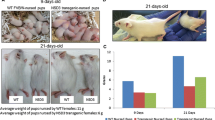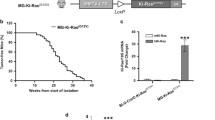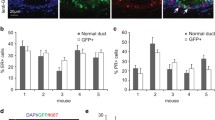Abstract
Background
ErbB-2 is a critical oncogenic marker in human breast cancer. Its appearance correlates with poor prognosis and it is, therefore, an important target for physiologic investigation and therapeutic intervention. With this in mind, we have created and characterized two mouse breast cancer models that express rat wild type neu, the homologue of ErbB-2, and rat mutant neu under the control of the normal mouse neu promoter. These models in which the copy number of the neu gene is moderately amplified should more closely parallel the expression pattern of ErbB-2 seen in some cases of human breast cancer.
Materials and Methods
Transgenic mouse models were constructed by injecting one of the two pronuclei of a fertilized FVB/n egg and implanting it into a pseudopregnant Swiss/Webster mouse. Tissue expression was analyzed through the use of reverse transcription polymerase chain reaction and mammary histopathology examined by fixing, staining and mounting of the entire gland.
Results
In the former wild type model, we show that low level, long term expression of neu leads to abnormal lobuloalveolar development in virginal glands and incomplete regression in multiparous glands. Malignant foci form following multiple rounds of pregnancy and regression. In the latter model, a similarly directed transgene carrying the constitutively activated, mutant form of the rat neu gene, a stronger but similar phenotype is displayed.
Conclusion
Evidently minor perturbations in amplified neu expression are sufficient to alter mammary development and induce malignant transformation.







Similar content being viewed by others
References
Shih C, Padhy LC, Murray M, Weinberg RA. (1981) Transforming genes of carcinomas and neuroblastomas introduced into mouse fibroblasts. Nature 290: 261–264.
King CR, Kraus MH, Aaronson SA. (1985) Amplification of a novel v-erbB-related gene in a human mammary carcinoma. Science 229: 974–976.
Coussens L, Yang-Feng TL, Liao YC, et al. (1985) Tyrosine kinase receptor with extensive homology to EGF receptor shares chromosomal location with neu oncogene. Science 230: 1132–1139.
Semba K, Kamata N, Toyoshima K, Yamamoto T. (1985) A v-erbB-related protooncogene, c-erbB-2, is distinct from the c-erbB-1/epidermal growth factor-receptor gene and is amplified in a human salivary gland adenocarcinoma. Proc. Natl. Acad. Sci. U.S.A. 82: 6497–6501.
Zeillinger R, Kury F, Czerwenka K, et al. (1989) HER-2 amplification, steroid receptors and epidermal growth factor receptor in primary breast cancer. Oncogene 4: 109–114.
Prigent SA, Lemoine NR. (1992) The type 1 (EGFR-related) family of growth factor receptors and their ligands. Prog. Growth Factor Res. 4: 1–24.
Slamon DJ, Godolphin W, Jones LA, et al. (1989) Studies of the HER-2/neu proto-oncogene in human breast and ovarian cancer. Science 244: 707–712.
Parkes HC, Lillycrop K, Howell A, Craig RK. (1990) C-erbB2 mRNA expression in human breast tumours: comparison with c-erbB2 DNA amplification and correlation with prognosis. Br. J. Cancer 61: 39–45.
Heintz NH, Leslie KO, Rogers LA, Howard PL. (1990) Amplification of the c-erb B-2 oncogene and prognosis of breast adenocarcinoma. Arch. Pathol. Lab. Med. 114: 160–163.
Tiwari RK, Borgen PI, Wong GY, Cordon CC, Osborne MP. (1992) HER-2/neu amplification and overexpression in primary human breast cancer is associated with early metastasis. Anticancer Res. 12: 419–425.
Makar A, Desmedt EJ, DePotter CT, Vanderheyden JD, Schatteman ES. (1990) Neu oncogene in breast cancer and its possible association with the risk of distant metastases. Acta Oncologica 29: 931–934.
Slamon DJ, Clark GM, Wong SG, Levin WJ, Ullrich A, McGuire WL. (1987) Human breast cancer: correlation of relapse and survival with amplification of the HER-2/neu oncogene. Science 235: 177–182.
Persons DL, Borelli KA, Hsu PH. (1997) Quantitation of HER-2/neu and c-myc gene amplification in breast carcinoma using fluorescence in situ hybridization. Mod. Pathol. 10: 720–727.
Berger MS, Locher GW, Saurer S, et al. (1988) Correlation of c-erbB-2 gene amplification and protein expression in human breast carcinoma with nodal status and nuclear grading. Cancer Res. 48: 1238–1243.
Hudziak RM, Schlessinger J, Ullrich A. (1987) Increased expression of the putative growth factor receptor p185HER2 causes transformation and tumorigenesis of NIH 3T3 cells. Proc. Natl. Acad. Sci. U.S.A. 84: 7159–7163.
Hung MC, Schechter AL, Chavray PY, Stern DF, Weinberg RA. (1986) Molecular cloning of the neu gene: absence of gross structural alteration in oncogenic alleles. Proc. Natl. Acad. Sci. U.S.A. 83: 261–264.
Di Marco E, Pierce JH, Knicley CL, Di Fiore PP. (1990) Transformation of NIH 3T3 cells by overexpression of the normal coding sequence of the rat neu gene. Mol. Cell Biol. 10: 3247–3252.
Muller WJ, Sinn E, Pattengale PK, Wallace R, Leder P. (1988) Single-step induction of mammary adenocarcinoma in transgenic mice bearing the activated c-neu oncogene. Cell 54: 105–115.
Guy CT, Webster MA, Schaller M, Parsons TJ, Cardiff RD, Muller WJ. (1992) Expression of the neu protooncogene in the mammary epithelium of transgenic mice induces metastatic disease. Proc. Natl. Acad. Sci. U.S.A. 89: 10578–10582.
White MR, Hung MC. (1992) Cloning and characterization of the mouse neu promoter. Oncogene 7: 677–683.
Cardiff RD, Muller WJ. (1993) Transgenic mouse models of mammary tumorigenesis. Cancer Surv. 16: 97–113.
Pittius CW, Sankaran L, Topper YJ, Henninghausen L. (1988) Comparison of the regulation of the whey acidic protein gene with that of a hybrid gene containing the whey acidic protein gene promoter in transgenic mice. Mol. Endocrinol. 2: 1027–1032.
Knepper JE, Medina D, Butel JS. (1986) Differential expression of endogenouse mouse mammary tumor virus genes during development of the BALB/c mammary gland. J. Virol. 59: 518–521.
Schroeder JA, Lee DC. (1998) Dynamic expression and activation of ERBB receptors in the developing mouse mammary gland. Cell Growth Differ. 9: 451–464.
Flanagan JG, Leder P. (1988) neu Protooncogene fused to an immunoglobulin heavy chain gene requires immunoglobulin light chain for cell surface expression and oncogenic transformation. Proc. Natl. Acad. Sci. U.S.A. 85: 8057–8061.
Dougall WC, Qian X, Peterson NC, Miller MJ, Samanta A, Green MI. (1994) The neu oncogene: signal transduction pathways, transformation mechanisms and evolving therapies. Oncogene 9: 2109–2123.
Sympson CJ, Talhouk RS, Alexander CM, et al. (1994) Targeted expression of stromelysin-1 in mammary gland provides evidence for a role of proteinases in branching morphogenesis and the requirement for an intact basement membrane for tissue-specific gene expression. J. Cell Biol. 125: 681–693.
Daniel CW, Silberstein GB. (1987) In: Neville MC, Daniels CW (eds.) The Mammary Gland Development, Regulation, and Function. Plenum Press, New York, N.Y., pp. 3–36.
Borellini F, Oka T. (1989) Growth control and differentiation in mammary epithelial cells. Environ. Health Perspect. 80: 85–99.
Lee M, Kim H, Jeon D, et al. (1996) Iron metabolism-related genes and mitochondrial genes are induced during involution of mouse mammary gland. Biochem. Biophys. Res. Commun. 224: 164–168.
Teng C, Pentecost BT, Chen YH, Newbold RR, Eddy EM, McLachlan JA. (1989) Lactotransferrin gene expression in the mouse uterus and mammary gland. Endocrinology 124: 992–999.
Strange R, Li F, Saurer S, Burkhardt A, Fris RR. (1992) Apoptotic cell death and tissue remodelling during mouse mammary gland involution. Development 115: 49–58.
Ross JS, Fletcher JA. (1998) The HER-2/neu oncogene in breast cancer: prognostic factor, predictive factor, and target for therapy. Stem Cells 16: 413–428.
Revillion F, Bonneterre J, Peyrat JP. (1998) ERBB2 oncogene in human breast cancer and its clinical significance. Eur. J. Cancer 34: 791–808.
Kokai Y, Cohen JA, Drebin JA, Greene MI. (1987) Stage- and tissue-specific expression of the neu oncogene in rat development. Proc. Natl. Acad. Sci. U.S.A. 84: 8498–8501.
Press MF, Cordon CC, Slamon DJ. (1990) Expression of the HER-2/neu proto-oncogene in normal human adult and fetal tissues. Oncogene 5: 953–962.
MacMahon B, Cole P, Lin TM, et al. (1970) Age at first birth and breast cancer risk. Bull. World Health Organ. 43: 209–221.
Siegel PM, Dankort DL, Hardy WR, Muller WJ. (1994) Novel activating mutations in the neu proto-oncogene involved in induction of mammary tumors. Mol. Cell Biol. 14: 7068–7077.
Acknowledgments
We would like to thank A. Harrington for microinjection and significant technical assistance and H. Chen and J. Pinkas for extensive review of this manuscript. We also thank M. Bedford, H. Chen, K Fitzgerald, and J. Pinkas for technical assistance and advice on experimental approaches.
Author information
Authors and Affiliations
Corresponding author
Additional information
Communicated by P. Leder.
Rights and permissions
About this article
Cite this article
Weinstein, E.J., Kitsberg, D.I. & Leder, P. A Mouse Model for Breast Cancer Induced by Amplification and Overexpression of the neu Promoter and Transgene. Mol Med 6, 4–16 (2000). https://doi.org/10.1007/BF03401930
Accepted:
Published:
Issue Date:
DOI: https://doi.org/10.1007/BF03401930




